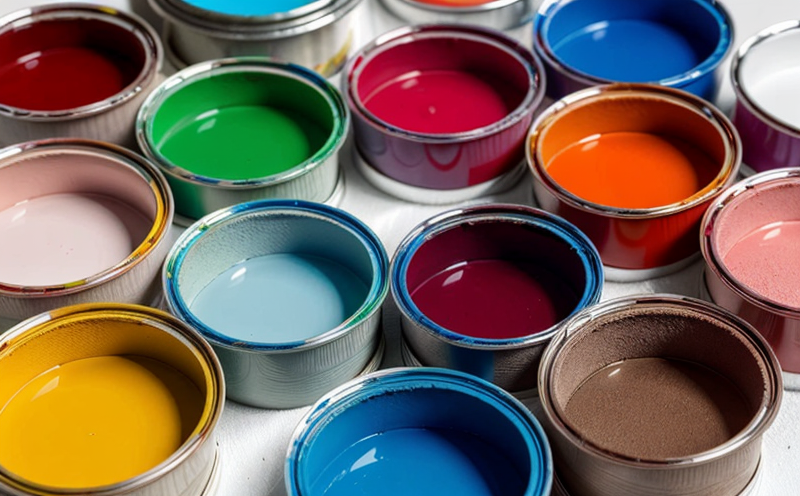ISO 8124-3 Organic Compounds in Coatings Test
The ISO 8124 series is a set of international standards that provide specific requirements and test methods for toys to ensure their safety, particularly regarding the presence of hazardous materials. Specifically, ISO 8124-3 focuses on organic compounds in coatings used on toy parts. This standard ensures that no harmful substances are released into the environment or to children when interacting with toys.
The test aims at identifying and quantifying volatile organic compounds (VOCs) as well as certain types of plasticizers, solvents, or other potentially hazardous chemicals present in coatings and paints used on toy parts. The standard is particularly relevant for ensuring compliance with regulatory requirements such as the European Union's Restriction of Hazardous Substances Directive (RoHS) and China's national standards.
The test method involves extracting the volatile organic compounds from the coating using a solvent, then analyzing the extract to identify and quantify the specific chemicals. The testing procedure is rigorous and requires precise handling of both the toys and the extraction solvents used in the process.
To ensure accurate results, laboratories must be equipped with state-of-the-art analytical instruments such as gas chromatography-mass spectrometry (GC-MS) or liquid chromatography-mass spectrometry (LC-MS). These instruments provide high sensitivity and specificity necessary for detecting trace amounts of harmful chemicals. The test protocol also includes detailed instructions on how to prepare the samples, including which solvents to use and at what temperatures.
The acceptance criteria are based on the maximum allowable concentrations set forth in relevant regulations such as RoHS or local toy safety standards. For example, if a toy part contains more than a specified amount of a particular chemical, it would be deemed non-compliant with this test.
| Key Elements | Description |
|---|---|
| Sample Preparation | Involves cleaning the toy part thoroughly and allowing it to dry before applying solvents for extraction. |
| Analytical Instrumentation | Use of GC-MS or LC-MS for accurate quantification of organic compounds in extracts. |
| Extraction Solvents | Specific solvents like methylene chloride or toluene are used depending on the type of coating being tested. |
| Acceptance Criteria | Based on regulatory limits for hazardous substances in coatings and paints. |
The importance of this test cannot be overstated, especially given that children often put toys into their mouths or chew on them. Ensuring the absence of harmful chemicals is crucial to protecting child health and safety. This test method helps manufacturers stay compliant with international standards while also safeguarding public health.
Given its complexity and significance, it's important for laboratories performing this test to have experienced personnel who understand both the technical aspects of the testing process as well as regulatory requirements. Proper training and equipment maintenance are essential to ensure accurate results every time.
Industry Applications
The ISO 8124-3 Organic Compounds in Coatings Test finds extensive application across various industries, particularly those dealing with children's products. Toy manufacturers, especially those operating internationally or targeting international markets, must adhere to this standard to ensure their products meet safety regulations.
| Industry | Description of Application |
|---|---|
| Toys & Games | Ensuring that all parts of the toy, including those that may come into contact with children's mouths, do not contain harmful chemicals. |
| Plastic Toys | Testing for plasticizers and other additives in plastic coatings to ensure they are safe for use by children. |
| Paint & Coating Manufacturers | Developing safer paints and coatings that meet the stringent requirements set forth by ISO 8124-3. |
| Distributor/Wholesalers | Verifying compliance with international standards before importing or selling toys in different countries. |
The test is also relevant for quality assurance departments within companies, helping them identify potential issues early on during the manufacturing process. Additionally, this test plays a crucial role in research and development efforts aimed at creating safer materials for children's products.
Why Choose This Test
The ISO 8124-3 Organic Compounds in Coatings Test is essential for several reasons. Firstly, it helps ensure compliance with international regulations such as RoHS and local toy safety standards. Secondly, it protects children from exposure to potentially harmful chemicals found in coatings used on toys.
- Ensures compliance with strict regulatory requirements.
- Protects public health by eliminating hazardous substances.
- Safeguards the reputation of manufacturers who adhere to high standards.
- Aids in quality assurance and product development.
The test is particularly beneficial for companies that want to expand into new markets or sell internationally. By ensuring their products meet these stringent safety requirements, they can avoid costly recalls and negative publicity. Additionally, it demonstrates a commitment to child welfare and safety, which can enhance brand reputation and consumer trust.
Use Cases and Application Examples
This test is used in numerous scenarios where the safety of children's toys and other products comes into question. Here are some specific examples:
- Testing new coatings before they are applied to toy parts.
- Inspecting imported toys for compliance with international standards.
- Identifying potential hazards during product development.
| Use Case | Description of Application |
|---|---|
| New Coatings Testing | Evaluating the safety profile of new coatings before they are used on toys. |
| Import Inspection | Verifying that imported toys meet international standards for toy safety. |
| Product Development | Identifying potential hazards during product development to ensure compliance with regulations. |
In all these scenarios, the test helps manufacturers and distributors make informed decisions about their products. It provides peace of mind knowing that the toys they produce or sell are safe for children to play with.





